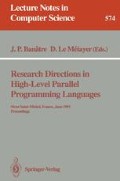Abstract
While the limelight has been focussed on the use of Linda to build efficient parallel programs, we have been steadily building a portfolio of successes in other areas of coordinated computing. It's time to make more of these efforts. They will begin to crowd center stage as open Linda systems—Linda systems that support access to the same tuple space from different executables—become more widely available, spawning a creative frenzy of coordinated programming.
From the perspective of the Linda project, these efforts emphasize the general utility of the Linda model. Few other approaches having some promise as tools for parallel computation maintain their attractiveness as tools for other sorts of distributed ensembles.
From a larger perspective, it is important to emphasize the full panoply of coordination applications. Arguably, significant future developments in large-scale systems will more often than not be members of this group. Current (over) emphasis on parallel computation risks stunting the development of the tools necessary to meet the needs of these next generation systems.
This research is supported by National Science Foundation grant CCR-8657615, by the Air Force Office of Scientific Research under grant number AFOSR-91-0098, and by NASA under NASA Training Grant NGT-50719.
This article was processed using the IIEX macro package with LMAMULT style
Preview
Unable to display preview. Download preview PDF.
References
Ahmed, S., Carriero, N., Gelernter, D., “The Linda Program Builder”, Proc. Third Workshop on Languages and Compilers for Parallelism (Irvine, 1990), MIT Press 1991.
Bjornson, R., Carriero, N., Gelernter, D., Kaminsky, D., Mattson, T., and Sherman, A. “Experience with Linda”, YALEU/DCS/TR-866, 8/91.
Carriero, N. and Gelernter, D., “How to Write Parallel Programs: A Guide to the Perplexed”, ACM Computing Surveys, (Sept. 1989).
Carriero, N., Gelernter D., and Mattson T., “Linda in Heterogeneous Computing Environments”, YALEU/DCS/TR-876, 10/91.
Ellis, C., Gibbs, S. and Rein, G., “Groupware: Some Issues and Experiences”, Communications of the ACM, (Jan. 1991):38–58.
Gates, E., Krauss, L., White, M., “Solar Neutrino Data and Its Implications”, YCTP-P26-91, Yale University, 8/91.
Gelernter, D. and Bernstein, A., “Distributed communication via global buffer,” in Proc. ACM Symp. Principles of Distributed Computing, (Aug. 1982):10–18.
Author information
Authors and Affiliations
Editor information
Rights and permissions
Copyright information
© 1992 Springer-Verlag Berlin Heidelberg
About this paper
Cite this paper
Hupfer, S., Kaminsky, D., Carriero, N., Gelernter, D. (1992). Coordination applications of Linda. In: Banâtre, J., Le Métayer, D. (eds) Reasearch Directions in High-Level Parallel Programming Languages. HLPPP 1991. Lecture Notes in Computer Science, vol 574. Springer, Berlin, Heidelberg. https://doi.org/10.1007/3-540-55160-3_43
Download citation
DOI: https://doi.org/10.1007/3-540-55160-3_43
Published:
Publisher Name: Springer, Berlin, Heidelberg
Print ISBN: 978-3-540-55160-7
Online ISBN: 978-3-540-46762-5
eBook Packages: Springer Book Archive

